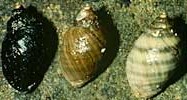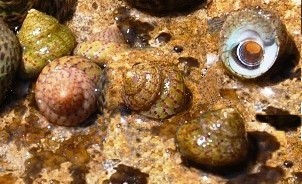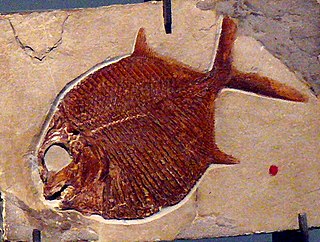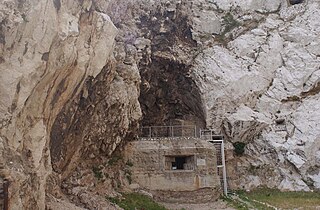
Rheidae is a family of flightless ratite birds which first appeared in the Paleocene. It is today represented by the sole living genus Rhea, but also contains several extinct genera.

Haminoeoidea is a taxonomic superfamily of small sea snails or bubble shells, marine opisthobranch gastropod mollusks in the clade Cephalaspidea, the headshield slugs and bubble snails.

Nucella, common name dog whelks or dog winkles, is a genus of small to medium-sized predatory sea snails, marine gastropod mollusks in the subfamily Ocenebrinae which is part of the large family Muricidae, the murex snails or rock snails.
Gujarat Vidya Sabha, originally called Gujarat Vernacular Society, is a literary institution for the promotion of vernacular Gujarati literature and education, and for the collection of manuscripts and printed books; located in the city of Ahmedabad, India. It was founded by a British administrator, Alexander Kinloch Forbes, in 1848 with the Gujarati author Dalpatram. The name was changed on the occasion of the centenary of the institution.

Eupterotidae is a family of insects in the order Lepidoptera with more than 300 described species.

Trochus is a genus of medium-sized to large, top-shaped sea snails with an operculum and a pearly inside to their shells, marine gastropod molluscs in the family Trochidae, the top snails.

Gibbula is a genus of small sea snails, marine gastropod molluscs in the subfamily Cantharidinae of the family Trochidae, the top snails.

Pycnodontiformes is an extinct order of bony fish. The group evolved during the Late Triassic and disappeared during the Eocene. The group has been found in rock formations in Africa, Asia, Europe, North and South America.

Hoploscaphites is an extinct ammonite genus from the Upper Cretaceous, included in the family Scaphitidae.

Lycia is a genus of moths in the family Geometridae.

Eubranchus is a genus of aeolid nudibranch in the family Eubranchidae.

Forbes' Quarry is located on the northern face of the Rock of Gibraltar within the Upper Rock Nature Reserve in the British Overseas Territory of Gibraltar. The area was quarried during the 19th century to supply stone for reinforcing the fortress' military installations. In the course of the quarrying, a limestone cave was found. The second ever Neanderthal discovery was made within this cave when Cpt. Edmund Flint found the skull of an adult female Neanderthal in 1848.

Corymorphidae is a family of hydroid cnidarians. For long placed in a presumed superfamily or infraorder Tubulariida of suborder Capitata, they are actually close relatives of the Hydridae and are now united with these and a number of relatives in a newly recognized suborder Aplanulata. Most, if not all species in this family grow on stalks and resemble small flowers.

Phialella is a genus of hydrozoans. It is the only genus within the monotypic family Phialellidae.

Heterocyathus is a genus of coral of the family Caryophylliidae.
Codonium is a genus of hydrozoans belonging to the family Corynidae.
Cosmetira is a monotypic genus of hydrozoans belonging to the family Mitrocomidae. The only species is Cosmetira pilosella.
Modeeria is a genus of hydrozoans belonging to the family Tiarannidae.

Nymphaster is a genus of echinoderms belonging to the family Goniasteridae.














